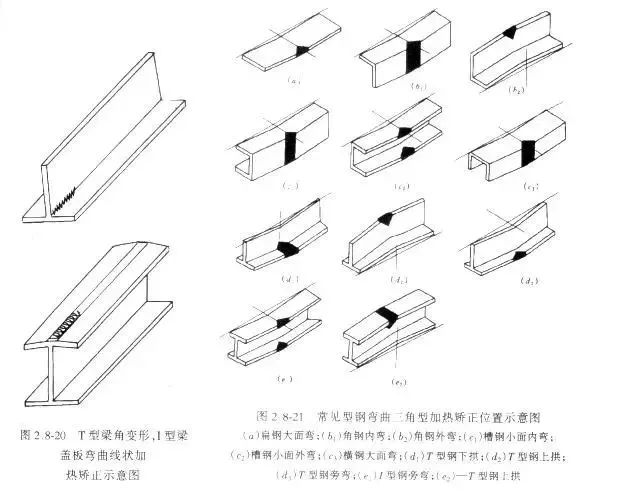The main components of the steel structure are welded H-shaped steel columns, beams and bracings. Welding deformation often uses the following three flame correction methods: (1) linear heating method; (2) Spot heating method; (3) Triangle heating method.
1. Correct the temperature
The following is the heating temperature during flame correction (made of mild steel)
Low temperature correction 500 degrees ~ 600 degrees Cooling method: water
Medium temperature correction 600 degrees ~ 700 degrees Cooling method: air and water
High temperature correction 700 degrees ~ 800 degrees Cooling method: air
Precautions: The heating temperature should not be too high when the flame correction is too high, and too high will cause the metal to become brittle and affect the impact toughness. 16Mn cannot be cooled with water during high temperature correction, including steels with greater thickness or hardening tendencies.
2. Correction method
2.1 Angular deformation of the flange plate
Correct the deformation of H-shaped steel columns, beams and support angles. On the flange plate (outside the alignment weld) longitudinal linear heating (heating temperature is controlled below 650 degrees), pay attention to the heating range does not exceed the range controlled by the two welding feet, so do not use water cooling. When heating in line, pay attention to: (1) should not be repeatedly heated in the same position; (2) Do not water during heating.
2.2 Upper arch and lower deflection and bending deformation
(1) On the flange plate, facing the longitudinal weld, from the middle to the two ends of the linear heating, you can correct the bending deformation. To avoid bending and twisting deformation, the two heating belts are carried out simultaneously. Low temperature correction or medium temperature correction can be used. This method is conducive to reducing the stress in the weld, but this method has a large lateral shrinkage at the same time as the longitudinal shrinkage, which is more difficult to master.
(2) Linear heating on the flange plate and triangular heating on the web. Use this method to correct the bending deformation of columns, beams, braces, the effect is remarkable, the horizontal linear heating width is generally taken 20-90mm, the plate thickness is hourly, the heating width should be narrower, and the heating process should be extended from the middle of the width to both sides. Linear heating is best operated by two people at the same time, and then heat the width of the triangle triangle should not exceed 2 times the thickness of the plate, and the bottom of the triangle is equal to the linear heating width of the corresponding wing plate. The heating triangle starts at the top and then expands from the center to the sides, heating up layer by layer until the bottom of the triangle. The temperature should not be too high when heating the web, otherwise it will cause depression deformation and be difficult to repair.
Note: The above triangle heating method is also applicable to the side bend correction of the component. When heating, medium temperature correction should be used, and watering should be less.
(3) Wave deformation of columns, beams and support webs
To correct the wave deformation, we must first find the raised peaks and use the dot heating method with the hand hammer to correct. The diameter of the heating dot is generally 50 ~ 90mm, when the thickness of the steel plate or the wavy area is large, the diameter should also be enlarged, which can be pressed d = (4δ + 10) mm (d is the diameter of the heating point; δ is the plate thickness) is calculated to calculate the value of heating. The grille moves in a spiral from the peak of the wave and is corrected at medium temperature. When the temperature reaches 600 to 700 degrees, the hammer is placed at the edge of the heating zone, and then the sledgehammer is used to hit the hammer, so that the metal in the heating zone is squeezed, and the cooling contraction is flattened. Excessive shrinkage stress should be avoided during correction. After correcting one dot, a second crest point is heated, as above. To speed up the cooling rate, the Q235 steel can be water cooled. This correction method belongs to the dot heating method, and the distribution of heating points can be plum-shaped or chain-type dense dots. Be careful not to exceed 750 degrees.

Corrective procedures for fillet welds
Fillet welds
Section 5.23 of the 2015 edition of AWS D1.1 deals with the provisions regarding acceptable and unacceptable welded profiles. When the size of the fillet weld is too large due to negligence, the welding profile provisions listed in Section 5.23 will be misunderstood. According to the American Steel Structure Association, assuming that excess weld metal does not interfere with the use of the end of the member, without correcting the fillet weld, it may cause the angular edges of the fillet weld (whether on one side or both sides) to be oversized. Attempting to remove the excess weld metal described above may result in shrinkage, deformation and/or rupture of the weld. The handling of the shape of the fillet weld shall follow the relevant requirements set forth in Section 5.23.1 of the 2015 edition of AWS D1.1.
What are the acceptable assembly conditions for forming a corner joint? Section 5.22.1 of the 2015 edition of AWS D1.1 states that the permissible root clearance cannot exceed 1.59mm (1/16 in.) without modification. In general, if the weld size increases with the increase of the root space or if it has been proven to obtain the required effective concave angle, the permissible root gap is considered not to exceed 4.76mm (3/16 in.). For thicknesses exceeding or equal to 76.2mm (3 in.) For steel plates, the permissible root clearance value is 7.94mm (5/16 in.) when using suitable pads.
Post time: Jun-06-2022
